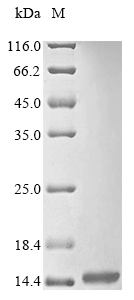Recombinant Tityus serrulatus Beta-mammal/insect toxin Ts1 is produced through a baculovirus expression system and includes the complete mature protein sequence spanning amino acids 21 to 81. The protein carries an N-terminal 10xHis-tag along with a C-terminal Myc-tag, which help streamline purification and detection processes. SDS-PAGE analysis shows the protein achieves greater than 85% purity, delivering what appears to be high-quality material for research work.
The Tityus serrulatus Beta-mammal/insect toxin Ts1 represents a well-characterized element of scorpion venom that targets ion channels with notable specificity. Researchers primarily turn to this protein when investigating ion channel modulation mechanisms, as it may provide valuable insights into neurophysiological processes and potential therapeutic targets. Its study seems particularly important in toxicology and pharmacology research.
Potential Applications
Note: The applications listed below are based on what we know about this protein's biological functions, published research, and experience from experts in the field. However, we haven't fully tested all of these applications ourselves yet. We'd recommend running some preliminary tests first to make sure they work for your specific research goals.
Tityus serrulatus Beta-mammal/insect toxin Ts1 is a small scorpion toxin (21-81aa) that requires precise folding, proper disulfide bond formation (typically 3-4 disulfide bonds), and specific tertiary structure for its ion channel binding activity. The baculovirus-insect cell expression system provides a eukaryotic environment that supports proper protein folding and disulfide bond formation, which is crucial for this toxin's structural integrity. However, the dual N-terminal 10xHis-tag and C-terminal Myc-tag are relatively large compared to the small toxin size (∼7 kDa mature protein), potentially causing significant steric interference with the toxin's functional domains and binding interfaces. While the expression system favors correct disulfide bonding, the protein's folding status and functional capability should be validated before its use in various applications.
1. Ion Channel Interaction Studies
This application carries a high risk due to potential structural interference from the dual tags. Ts1's ion channel binding requires precise three-dimensional structure formation with specific disulfide bonding. The large tags (∼15 kDa combined) relative to the small toxin (∼7 kDa) may sterically block binding sites or alter conformational dynamics. If correctly folded and functionally validated (verified), limited qualitative studies may be possible. If unverified, electrophysiological results will be unreliable for determining true binding characteristics.
2. Antibody Development and Immunoassay Applications
This application is highly suitable as antibody generation depends on linear epitope availability. The full-length mature toxin provides complete antigenic coverage, and the dual tags offer additional epitopes for antibody screening. While the tags may alter some conformational epitopes, the core toxin sequence remains available for generating specific antibodies against native Ts1 epitopes.
3. Structure-Function Relationship Studies
This application requires careful interpretation due to tag interference. While comparative studies with mutant variants are possible, the tags may mask or alter structure-activity relationships. Meaningful functional comparisons require tag-free constructs to avoid confounding effects on toxin function and binding characteristics.
4. Biochemical Characterization and Stability Studies
These studies are essential priority applications for assessing folding quality. Techniques should focus on disulfide bond analysis (mass spectrometry), circular dichroism spectroscopy to evaluate secondary structure, and thermal stability assays. However, results will reflect the tagged protein's properties rather than the native toxin's characteristics.
Final Recommendation & Action Plan
The baculovirus system provides favorable disulfide bond formation capabilities for this scorpion toxin, but the large dual-tag configuration relative to the small toxin size creates a significant risk of structural distortion and functional impairment. Begin with Application 4 (Biochemical Characterization) to assess disulfide bonding patterns and structural integrity. Applications 2 (Antibody Development) can proceed immediately. Protein-protein interaction screening studies are not recommended due to the high probability of structural distortion. For Applications 1 and 3 (Ion Channel Studies and Structure-Function), first validate functionality with known ion channel targets and compare results with tag-free toxin constructs. Given the size disparity between tags and toxin, consider using tag-free constructs for all functional studies requiring native toxin activity.






